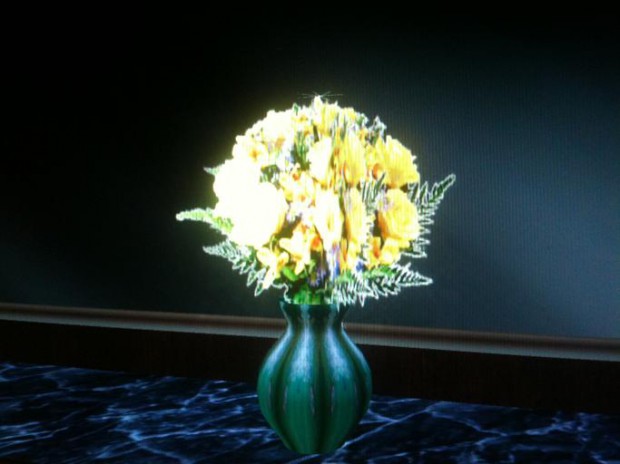
SARA LUDY, Bouquet, 2012 at Paddles ON!
Looks like Paddles ON! London, is on its way to replicating the strides made during last year’s much-discussed net-art auction, the first at a major auction house. Last fall, the auction held in New York at Phillips totalled $90,600 on the sale of 16 pieces out of 20 lots. People widely lauded the auction as a success—a GIF sold for $1,300 and the excitement from the live auction crowd was palpable—but financially, the case for Paddles ON! achievements aren’t clear cut. Nine of the works sold for less than their estimated bids, and four of those were not sold by the auction house.
This time around the approach and response to the auction appears to be consistent with Phillip’s previous effort. Paddles ON! takes a continued cautious approach to the digital market; with twenty-two collector-friendly artworks, they’ve increased the number of auction lots by only two works, and the highest-priced item lists an estimate of £6,000-£7,000. Artists include Laura Brothers (of the beautiful livejournal out_4_pizza), Sara Ludy (represented by Klaus von Nichtssagend), and Dora Budor and Maja Cule (both formerly of Dora & Maja). Eight of the 22 artists are EU-based. This year’s auction also comes with a picture of Yung Jake across from a Damien Hirst.
Curated once more by Lindsay Howard, the auction departs from Howard’s own earlier experiments with the digital market. Two years ago, Howard put together the online exhibition C.R.E.A.M. for Art Micro Patronage, which tested out a donation model of exhibition funding for historical net-based work. We had hopes for that model; but speaking perhaps to the lack of community funding, the drive netted $211.24.
Those problems go unanswered in this effort, which is less about exploring experimental models than building a digital market. Originally conceived by Megan Newsome, Phillips Head of Sale for the auction, Paddles ON! and Annie Werner, Tumblr’s art evangelist, the auction consists almost entirely of wall-mountable prints and sculptures. A bidding war is already happening on Paddle8 over a pastel-colored, digitally-printed painting by Michael Manning, with 15 bids now at £7,000. This is consistent with Manning’s performance at the Rhizome Seven on Seven benefit, during which, the bidding was similarly heated. So far five other works have bids, with activity generally mapping to the better known artists. Evan Roth of Graffiti Research lab recently procured a bid at £3,000 for his smudge on dibond and Michael Staniak’s abstract monochrome made from casting compound and acrylic on board is at £4,100.
There’s still five days left in the silent auction before it transfers to the live site, so we expect a lot will change between then and now. And of course, if Phillip’s first effort in New York was any indication, the real action will take place during the live auction.
Participating artists and galleries receive 100% of the proceeds and a portion of the buyers premium goes to Opening Times (a London-based nonprofit that provides commissions for digital artists).


{ 6 comments }
“Paddles ON! consists almost entirely of wall-mountable prints and sculptures.” :/
Right?!
Hi Nick,
That’s not an accurate statement, and is pretty reductive in terms of how these artists are thinking about their practices.
Strictly in terms of medium, there are 3 digital prints (one of them sold with a digital file in Google Earth), 3 digital photographs, 2 3-D printed sculptures, 3 sculptures made with digital materials, 3 videos, 3 digital paintings, 2 paintings, 1 piece of custom software, 1 painting generated by an algorithm, and 1 video installation.
I would encourage anyone who’s interested in learning about these exciting pieces to read the catalogue essays that are on Paddle8 or my curatorial essay, which is posted on our Tumblr.
http://paddle8.com/auctions/paddleson
http://paddleson.tumblr.com
Or you can @Lindsay_Howard and we can chat directly.
Hi Lindsay,
Thanks for your feedback. It’s not actually *that* reductive. 5 sculptures and 6 prints/photographs is a lot. Add to this that you’ve got 6 paintings and 3 videos, and you’re looking at the bulk of material being wall mounted.
I don’t see this as being an issue in the context of auction. It’s simply a reality.
Hi Lindsay,
Just echoing a line from the article that interested me. And re-investing into a topic/conversation I was looking into and discussing with you and others during last year’s auction.
Jumping off of your curatorial and catalogue essays use and definition of the word digital. I have to echo Paddy’s comment, I don’t see it as being an issue in the context of this auction. My :/ was aimed towards other, future sales of digital art.
It could be an issue moving forward with other digital art sales/auctions, when buyers/collectors/auction goers will be looking to purchase digital art as physical work. Which might not be suitable, or the best approach for all digital artists. Just some thoughts and potential conversations, potentially worth having 🙂
Honestly, I think that issue is inevitable, as it’s an issue with all markets. We probably all know a painter or a sculptor who also makes unsalable performance (Jose Lerma) or performance artists who use the sale of props from those pieces to fund their work (Matthew Barney). Those who don’t make work that has an obvious market often end up on the non-profit circuit (Caroline Woolard).
Exactly defines an digital artist is a little murky to me. They’re described as artists who use the computer as a central part of their practice, but that’s a lot of artists. What makes what Michael Manning produces different from any other artist who prints on canvas? It seems like some of it is an ethos that comes out of a particular social circle defined by interest. Maybe this what The Pictures Generation looks like in 2014.
Comments on this entry are closed.